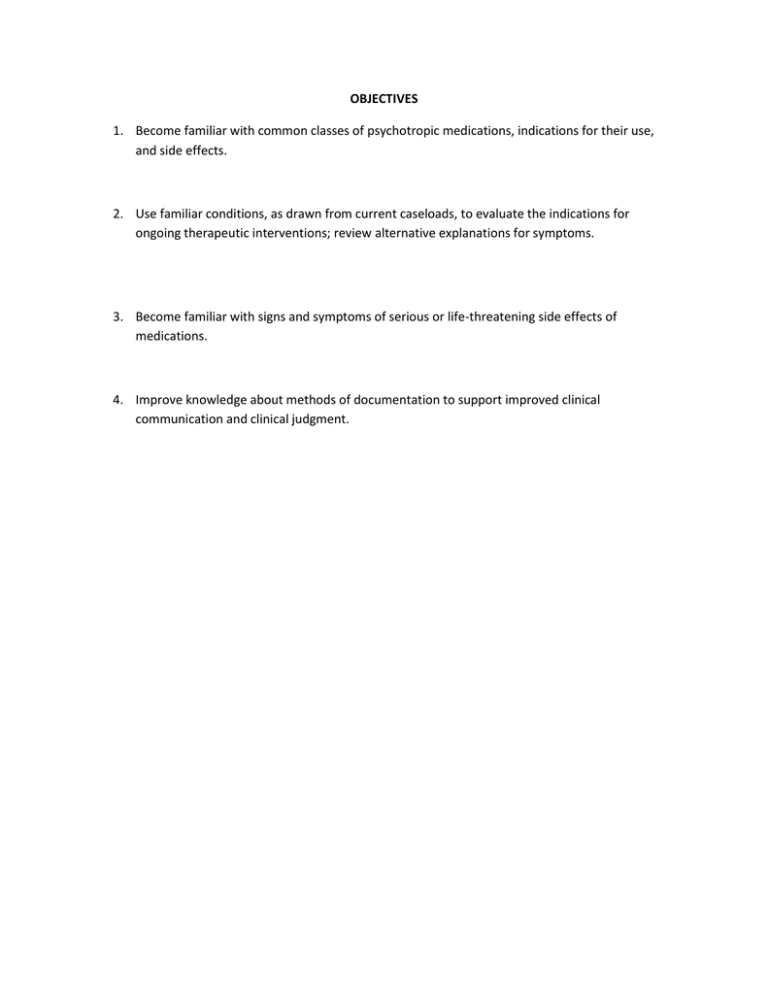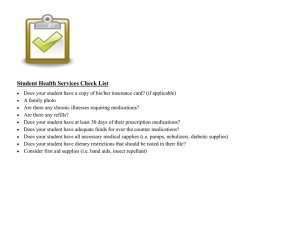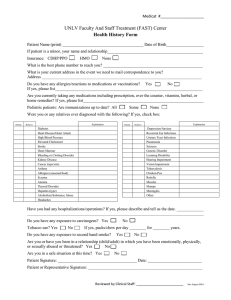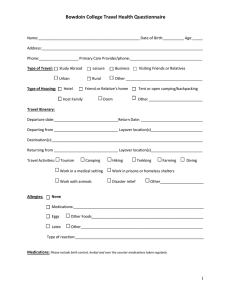OBJECTIVES 1. Become familiar with common classes of
advertisement

OBJECTIVES 1. Become familiar with common classes of psychotropic medications, indications for their use, and side effects. 2. Use familiar conditions, as drawn from current caseloads, to evaluate the indications for ongoing therapeutic interventions; review alternative explanations for symptoms. 3. Become familiar with signs and symptoms of serious or life-threatening side effects of medications. 4. Improve knowledge about methods of documentation to support improved clinical communication and clinical judgment. Assessing Abnormal Behavior I. Context for Mental Health Behavior a. Overall quality of life b. Wellness c. Relationships d. Coping e. Symptom management II. Accurate observation of person’s typical behavior a. Systematic methods of observation and recording b. Identification of observer bias and counter-transference III. What makes behavior AB-normal a. Cultural and social context for normal behavior b. Lack of ability to adapt to differing environments c. Distress, impairment of function; effects on people surrounding them. d. Dangerous behaviors IV. Whose problem is it? a. Safety concerns b. Noise and disruption – standards within the current living context c. Uncovering bias in caregivers and providers d. Challenging the habit of learned behavior – individual with I/DD and provider. Good & Bad Uses of Rxs: Principles of Psychopharmacology I. Valid reasons for using medications a. Safety b. Improve function c. Ameliorate symptoms d. Treat a recognized disorder (medical or psychiatric) e. Prevention of worsening condition f. II. Prior to procedures Poor justifications for use of medications a. Convenience b. Restraint c. Forgetting to review need for medication d. Adding on without consideration of drug-drug interactions or underlying cause(s) III. Linking symptoms and medications a. Accurate assessment: includes vegetative symptoms and disruption of diurnal cycle i. E.g. agitation may be caused by dementia, anger, sadness, anxiety… b. Determination if persons with I/DD want medications (competence of self/guardian) c. Medications may have off-(FDA approved)-label uses IV. Classes of medication a. Anxiolytic: benzodiazepines; buspirone, tricyclics, beta-blockers, SSRIs, SNRIs b. Antidepressant: tricyclics, SSRIs, MAOIs, SNRIs c. Antipsychotic: traditional and atypical; reason for monitoring d. Sedative-hypnotics: sleep-aides; antihistamines e. Pain relieving medications: gabapentin, lyrica, ibuprofen. V. Dealing with side effects a. Risks in polypharmacy. b. Management of acute dystonia c. Akasthisia d. Neuroleptic Malignant Syndrome “dry as a bone; mad as a hatter; hot as the sun; sore as a run” e. Tardive Dyskinesia: AIMS = abnormal involuntary movement scale; DISCUS Case examples and Discussion I. Illustrate importance of stepwise diagnostic identification of symptoms and applying treatment a. (use case) to illustrate sequential diagnosis of bipolar disorder, anxiety disorder, attention deficit disorder, borderline personality disorder and the pharmacologic and psychotherapeutic supports that were used. II. Respond to case material provided by audience participants a. Consider alternate diagnostic possibilities; etiologies. b. Non-medication therapies influencing symptoms c. Social context: housing, friends, religious affiliations, community settings, family… III. “Behavior” leads to erroneous conclusions a. Determine etiology/etiologies behind the behavior that is of concern b. Illustrations of mis-understanding about behavior Integrating medication/behavior/environment I. Considering the whole person – a holistic approach a. Assure values are recognized and respected b. Determine the circle of trust for the person – prevent unnecessary disclosures. II. Multiple etiologies in same person a. Seizure disorder b. Endocrine disorders c. Cardiovascular and pulmonary diseases d. Allergies III. Environmental and emotional triggers a. Environment is macro and micro; not just physical attributes of the environment IV. Reassess the diagnostic hypothesis and adjust treatment accordingly a. Always develop a working hypothesis, then let information guide the assessment and further treatment decisions. b. Involve patient at level where team can facilitate a positive impact. V. Listen to the patient, and their team a. Invite discussion and questions from team members. b. Use people-first language, whether or not the patient is fluent in any language.





